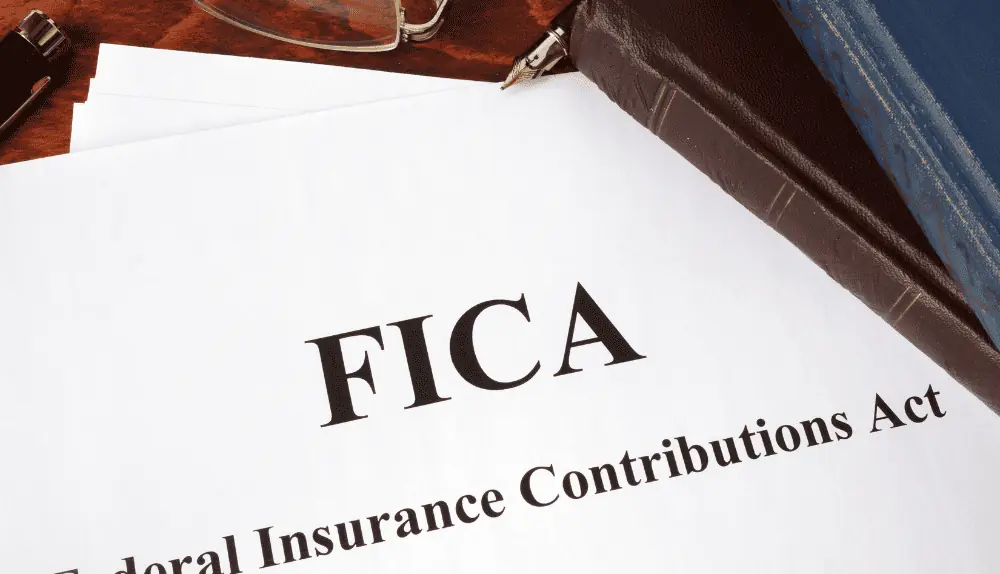Are you tired of feeling like Uncle Sam’s favorite ATM every time you receive your paycheck? Well, get ready to regain control of your hard-earned money! Today, we’ll delve into the fascinating world of FICA tax limits and rates. Whether you’re an employee eager to understand how much of your income goes towards Social Security and Medicare or an employer seeking to navigate the complex tax landscape, we’ve got you covered. Join us as we unravel the mysteries of FICA taxes, empowering you to make informed financial decisions and keep more of your cash where it belongs: in your pocket!
What is FICA Tax?

The FICA tax, also known as the Federal Insurance Contributions Act tax, is a mandatory payroll tax in the United States that pays two major social insurance programs: Social Security and Medicare. It is placed on both employees and employers to preserve the financial stability of these programs, which give benefits to retired people, people with disabilities, and people in need of medical care.
The FICA tax is computed as a percentage of an employee’s wages, and the revenues raised are used to provide a variety of benefits and services for qualified persons throughout their lives. Understanding the complexities of FICA tax is critical for both individuals and businesses in order to manage their finances and adhere to tax requirements efficiently.
Social Security Tax
The Social Security tax is an important component of the Federal Insurance Contributions Act (FICA) tax in the United States. It is intended to offer economic support to retired people, disabled people, and survivors of dead workers. The Social Security levy is paid to both employees and employers in order to create a long-term fund for various benefit programs.
As of September 2021, the Social Security tax rate for both employees and employers is 6.2%, for a total of 12.4% when combined. However, it is crucial to remember that this rate is subject to change, so it is best to verify the most recent data from the Social Security Administration or the IRS.
Employers often deduct the Social Security tax from their employees’ pay. The amount withheld is determined by the employee’s gross earnings up to a certain yearly income level known as the Social Security wage base. The wage base in 2021 was $142,800, meaning only wages up to this amount were subject to Social Security tax.
According to recent announcement made by Social Security Adiministration there are some changes made to the Social Security tax for the year 2023. These changes are important to understand as they can affect both employers and employees.
In 2023, the maximum amount of earnings for social security tax will increase from to $160,200. This means that any earnings above $160,200 will not be subject to Social Security tax.
Additionally, the maximum contribution made by Social Security employer will increase by $818.40 in 2023. This is the amount that employers contribute towards Social Security taxes for their employees.
For the year 2023, employers and employees will have a FICA tax rate of 7.65%. This rate is divided into two parts: 6.2% for Old-Age, Survivors, and Disability Insurance (OASDI), commonly known as Social Security, and 1.45% for Medicare.
As an employer in 2023, it is important to understand your withholding responsibilities. Here is a breakdown of what you must withhold from your employees’ wages:
- 6.2% of their wages, up to the first $160,200, for Social Security tax. The maximum tax amount for this category is $9,932.40, which is calculated by multiplying 6.2% by $160,200.
- 1.45% of their wages, up to the first $200,000, for Medicare tax.
- An additional 0.9% of their wages, known as the additional Medicare tax, for all earnings exceeding $200,000. This brings the total Medicare tax rate for these higher earnings to 2.35%.
- It is essential to keep these figures in mind when calculating the appropriate withholding amounts for Social Security and Medicare taxes in 2023.
It is worth noting that the Social Security tax rate and wage base are modified regularly to account for inflation and other economic considerations. It is critical for individuals to stay updated about these changes in order to organize their finances and understand their tax obligations effectively.
Medicare Tax
The Medicare tax is an important component of the Federal Insurance Contributions Act (FICA) tax system, which funds healthcare coverage for the elderly and disabled in the US. Let’s get into the details in a polite and understandable manner.
The Medicare tax is a component of the FICA tax that contributes to the funding of the Medicare program. It applies to both employees and employers and aims to ensure that eligible individuals have access to medical treatments.
As of September 2021, the Medicare tax rate is 1.45% for both employees and employers, for a total of 2.9% when combined. However, according to IRS official website, the Medicare tax rate is 1.45% for the employee and employer. This tax rate has been in place since 2022. It’s important to note that this rate is subject to change, so keep an eye out for updates from the Social Security Administration or the Internal Revenue Service.
Unlike the Social Security tax, the Medicare tax has no income ceiling or wage base. It is applicable to all earnings, regardless of the amount. So, regardless of whether you earn $30,000 or $300,000, you will contribute the same percentage of your income to Medicare.
Understanding the Medicare tax allows individuals and businesses to manage their finances better and satisfy their tax obligations while also supporting critical healthcare programs for those in need.
Key Facts About FICA Tax

- Social Security Funding: The Social Security portion of the FICA tax is largely used to support the Old Age, Survivors, and Disability Insurance (OASDI) program. It provides retirement benefits to qualifying persons, survivors of deceased workers’ benefits, and disability payments to those who are unable to work due to a disability.
- Medicare Funding: The Medicare share of the FICA tax pays for the Medicare program, which provides health insurance to people 65 and older and certain younger people with disabilities. Part A (hospital insurance), Part B (medical insurance), Part C (Medicare Advantage plans), and Part D (prescription drug coverage) comprise Medicare.
- Self-Employment: Self-employed people must pay both the employee and employer halves of the FICA tax. The current combined rate of 15.3% is known as the self-employment tax.
- Additional Medicare Tax: On wages exceeding specific levels, high-income earners may be liable to an Additional Medicare Tax of 0.9%. Individuals have a $200,000 exemption ($250,000 for married couples filing jointly).
- Future Sustainability: Concerns have been raised concerning the long-term viability of Social Security and Medicare due to issues such as an aging population and shifting demographics. Policy talks and prospective modifications are ongoing to ensure the programs’ long-term survival.
- Reporting and Compliance: Employers are responsible for appropriately computing and withholding FICA taxes from their employees’ earnings. They must record and pay these taxes to the government on a regular basis, adhering to the IRS’s specified requirements and timeframes.
- Exemptions and Non-Resident Aliens: Under certain conditions, some individuals, such as members of certain religious groups and non-resident aliens, may be excluded from paying FICA tax. To determine eligibility, you should check the IRS rules or a tax specialist.
Understanding these in-depth facts about FICA tax gives you a better understanding of how Social Security and Medicare are funded and operated, as well as the duties of employers and self-employed individuals in satisfying their tax commitments.
FICA Tax Limit in 2023
The magic number for the year 2023 is $160,200. So, until an employee’s hard-earned income exceed this level, they must continue to pay the appropriate Social Security payment. It’s similar to having a savings goal, with each paycheck chipping away at it until they reach it.
Now be ready for some amazing trivia. In 2023, the Social Security maximum benefit increased by the most in history—a stunning $13,200! This increase reflects the upward trend in national average wages, bringing the cap in line with the changing economic reality. It’s like scaling new heights, with rises more than double from the previous year.
But hold on; there’s more! When an individual’s earnings reach $200,000 in 2023, the Additional Medicare Tax kicks in. When individuals reach that threshold, a 0.9% surtax is imposed, adding another degree of responsibility to their tax duties. It’s like a little something more for individuals in higher wage brackets.
The surtax level is set at $250,000 for married taxpayers filing jointly and $125,000 for married taxpayers filing separately. It is a method of ensuring fairness and adjusting the rules based on various filing conditions.
Keep these fascinating facts in mind as you negotiate the tax landscape this year. Remember that new restrictions and thresholds are introduced each year to reflect the changing financial circumstances and to help develop a more equal system for all taxpayers.
Wage Base Limits for FICA Tax
When businesses discuss wage base restrictions, they are referring to the maximum amount an employee can make before Social Security taxes are no longer withheld from their paycheck.
This maximum sum, commonly known as the pay base limit, is set at $160,200 for the year 2023. It’s worth noting that there is no wage cap for Medicare taxes. Even if an employee exceeds the Social Security wage base limit, 1.45% of their taxable gross wages will be withheld for Medicare taxes.
Now, here’s something else to think about. If an employee’s earnings exceed $200,000, there is an additional tax to consider: the Additional Medicare Tax. This means an additional 0.9% of their income will be withheld to cover the surtax.
Employers and employees can both keep informed about their tax obligations and ensure appropriate withholdings throughout the year by recognizing these restrictions and thresholds.
Overpaying Taxes
Overpaying taxes can occur for a variety of causes, with financial and administrative consequences. Individuals and businesses who pay more than their real tax due effectively gift the government with an interest-free loan. Overpaying taxes may appear to be a noble gesture, but it means tying up important assets that may be utilized for other purposes, such as investments or savings.
Fear of underpayment and subsequent fines is a common motive for overpaying. Miscalculations, misconceptions of tax legislation, or inaccurate information on tax forms can also result in an overpayment. Some taxpayers prefer to err on the side of caution and overpay in order to avoid any potential consequences.
To prevent overpaying taxes, income, deductions, and credits must be calculated and reported correctly. Tax planning tactics, such as forecasting tax liabilities throughout the year and modifying withholding or projected tax payments accordingly, can assist in aligning tax payments with actual liability.
In the event of an overpayment, taxpayers can often obtain a refund by filing their tax forms appropriately and on time. However, it is crucial to note that in some circumstances, filing updated forms may be required.
Overall, understanding tax rules, staying organized, and getting professional advice can help people and organizations avoid overpaying taxes and make the best use of their financial resources.
FICA Tax Exemptions
FICA tax exemptions exempt certain individuals from paying all or a portion of their Federal Insurance Contributions Act (FICA) taxes. While the FICA tax is normally necessary for most employees and companies, there are certain situations and categories of people who may be exempt. Consider the following crucial points:
Religious Exemptions
If certain standards are met, members of certain religious groups may be excluded from paying FICA taxes. Being a member of a recognized religious group or division that has established doctrines or teachings opposing the receipt of public insurance benefits, such as Social Security or Medicare, is often one of these conditions.
Non-Resident Aliens
Individuals who do not meet the criteria for being categorized as U.S. residents for tax purposes, such as non-resident aliens, may be excluded from paying FICA taxes on income obtained from services performed in the United States. However, some conditions and eligibility criteria must be met.
Student Exemptions
Full-time students who work for their school, college, or university may be excused from paying FICA taxes on income received through work-study programs or research assistantships. Part-time students, on the other hand, are often ineligible for this exemption.
Non-U.S. Citizens Working on Temporary Visas
Non-U.S. citizens working in the United States on temporary visas, such as H-1B or J-1 visas, may be free from FICA taxes, depending on the terms of their visa and the nature of their employment.
It should be noted that FICA tax exemptions are limited to certain circumstances and eligibility criteria. Individuals seeking exemptions should check with the IRS, tax specialists, or their employers to confirm eligibility and assure compliance with tax requirements.
Individuals may also be subject to other taxes, such as federal income tax, state income tax, or other applicable taxes, even if an exemption applies. Understanding the complexities of FICA tax exemptions can assist individuals in navigating their tax obligations and making sound financial decisions.
FICA Tax Rates for Self-Employed
The Federal Insurance Contributions Act (FICA) tax rates for self-employed individuals fluctuate slightly from those for employees. When you work for yourself, you must pay both the employee and employer halves of the FICA tax, also known as self-employment tax.
The self-employment tax rate is 15.3% of your net profits. This figure is broken down into two parts: 12.4% for Social Security and 2.9% for Medicare.
The Medicare tax stays unchanged for both workers and self-employed people. However, there is a minor distinction when calculating self-employment tax. Employees share the 12.4% Social Security tax with their employers, whereas self-employed individuals must pay the entire 12.4%.
It’s worth noting that the self-employment tax only applies to net profits, which are your entire business income, less any permissible business expenses, and deductions. Schedule SE (Form 1040) must be used to record and pay self-employment tax on your annual tax return.
Understanding FICA tax rates for self-employed individuals is critical for correctly calculating and meeting your tax responsibilities. Keeping track of your earnings, deductions, and accurate reporting will help in tax compliance and financial planning for self-employed people.
Conclusion
In conclusion, understanding FICA tax and its various aspects, such as tax limits, rates, exemptions, and implications for self-employed individuals, is essential for navigating the complex world of taxes. Whether it’s keeping track of wage base limits, exploring exemptions for specific circumstances, or calculating self-employment tax rates, understanding the FICA tax empowers taxpayers to navigate the tax landscape effectively.
By staying informed about FICA tax regulations, individuals and employers can fulfill their tax obligations accurately, avoid overpaying or underpaying taxes, and make informed financial decisions. FICA tax, consisting of Social Security and Medicare taxes, plays a vital role in funding important social insurance programs that support retirees, disabled individuals, and healthcare coverage for the elderly and disabled.
It’s important to stay updated with the latest regulations, consult tax professionals when needed, and ensure compliance to contribute to the sustainability of these essential social insurance programs.

